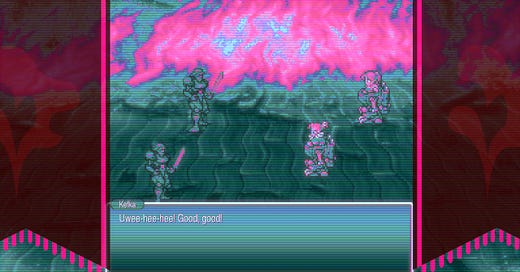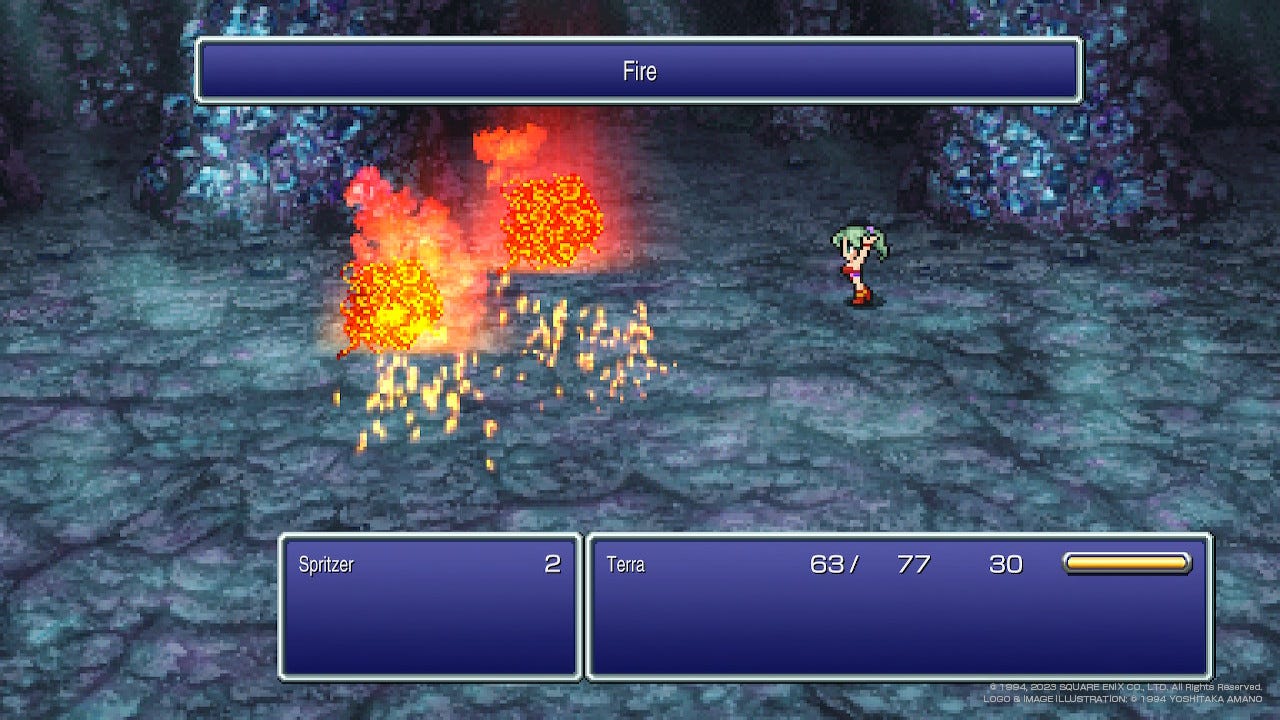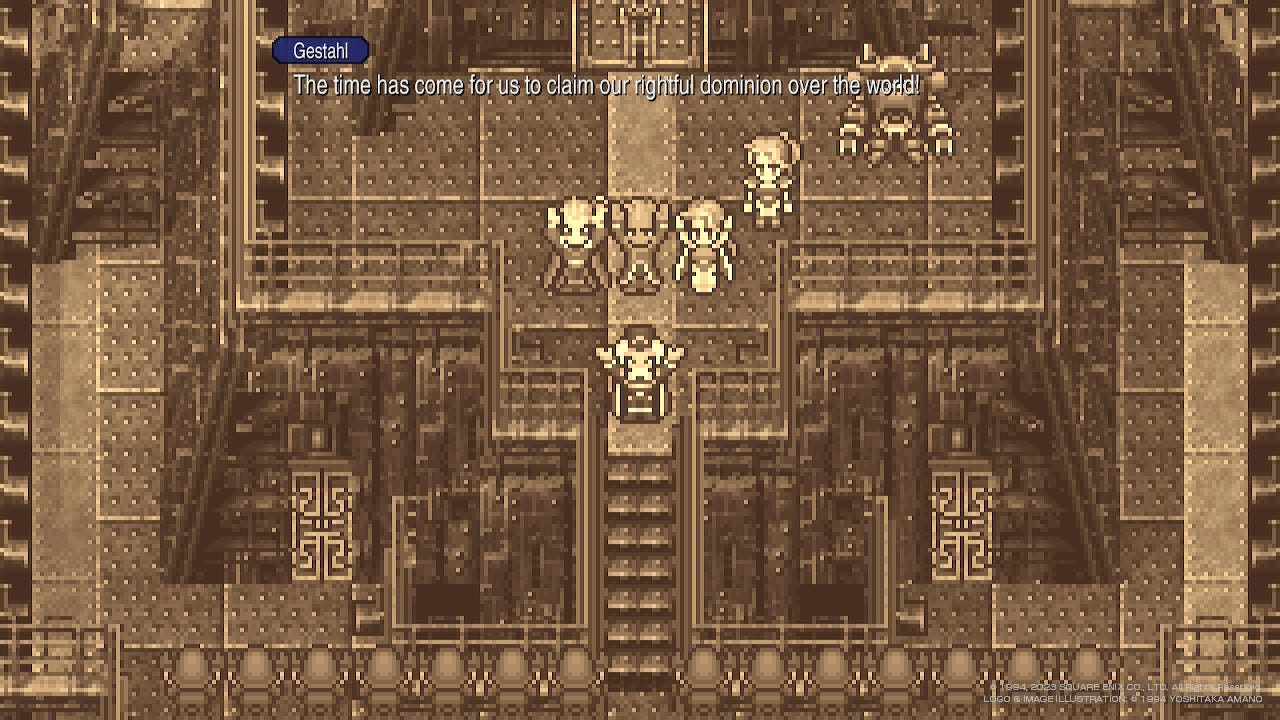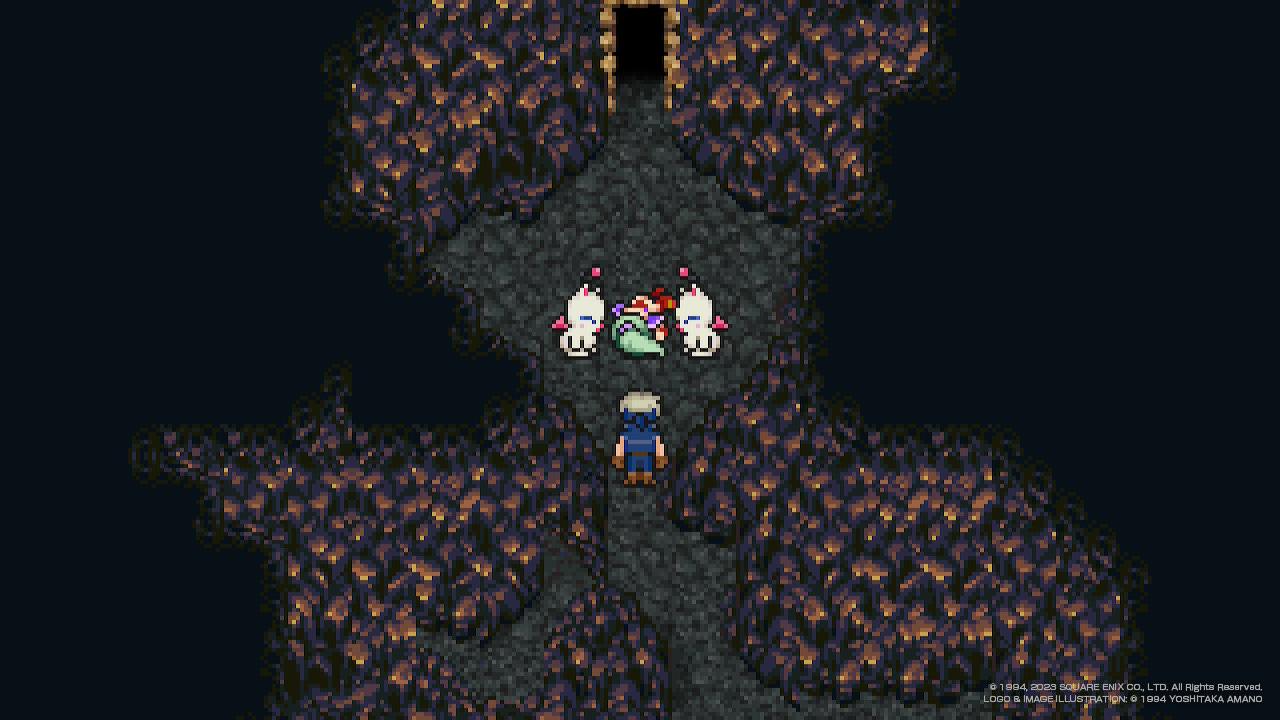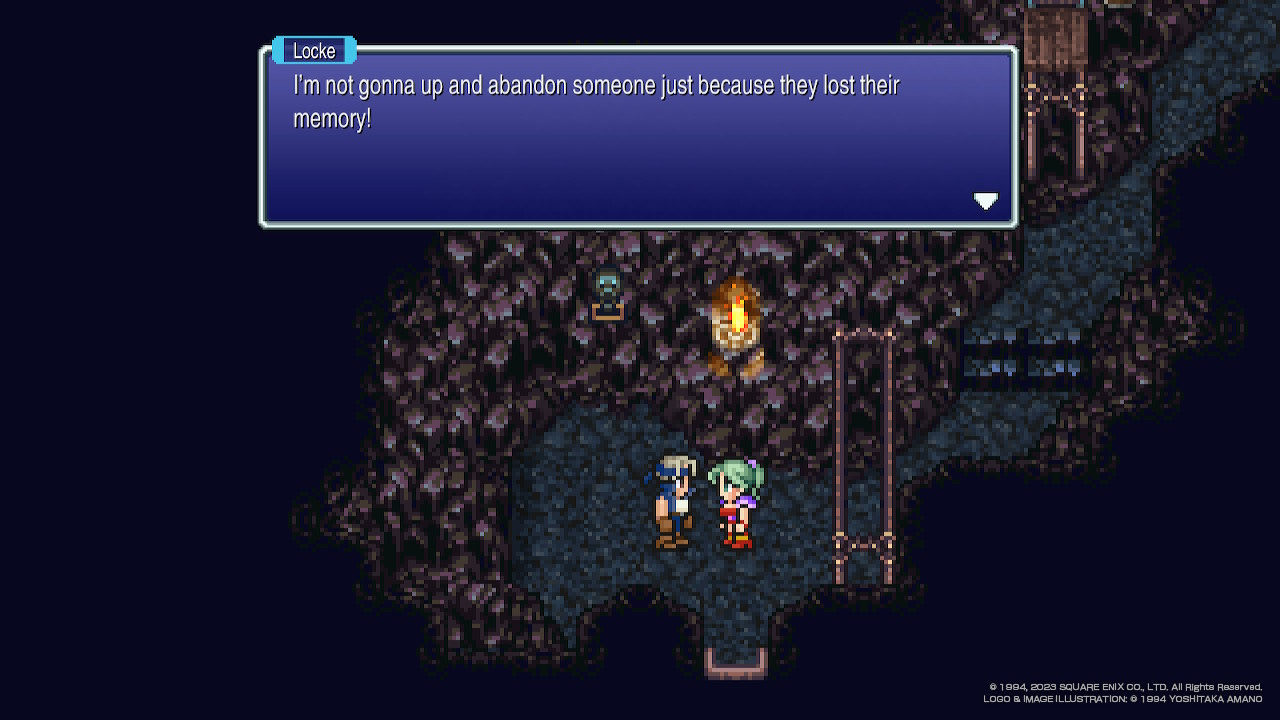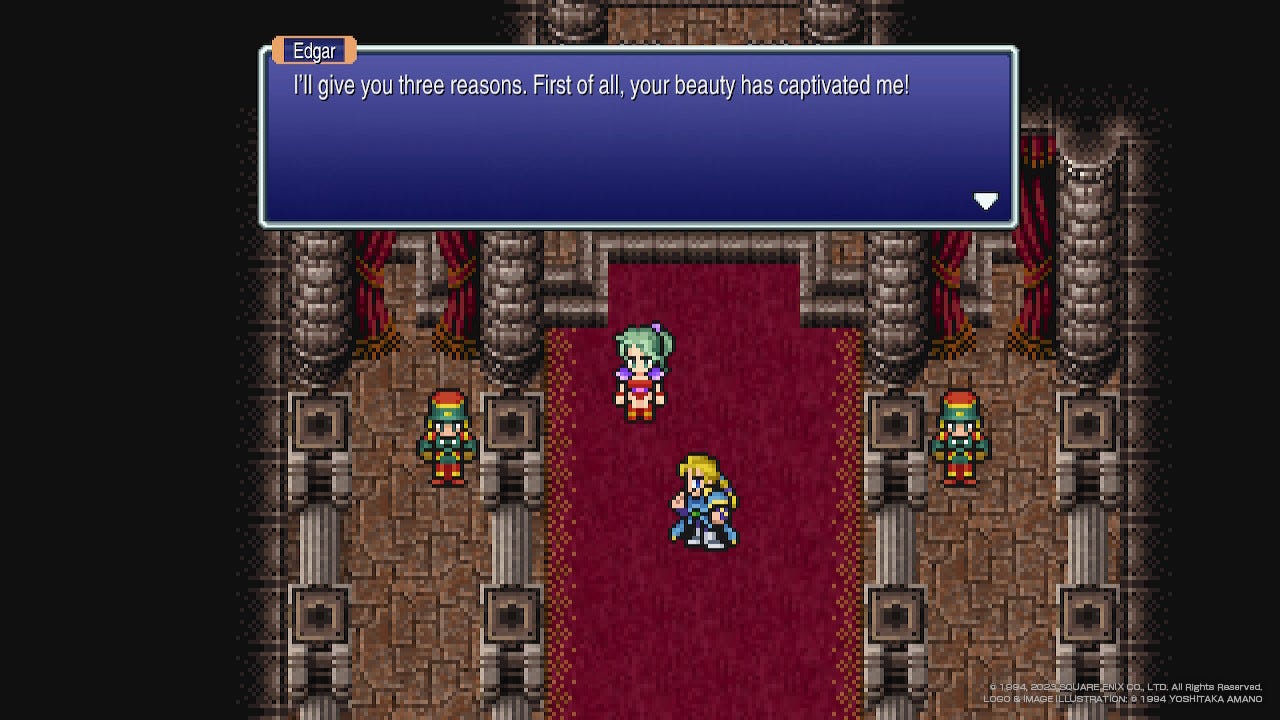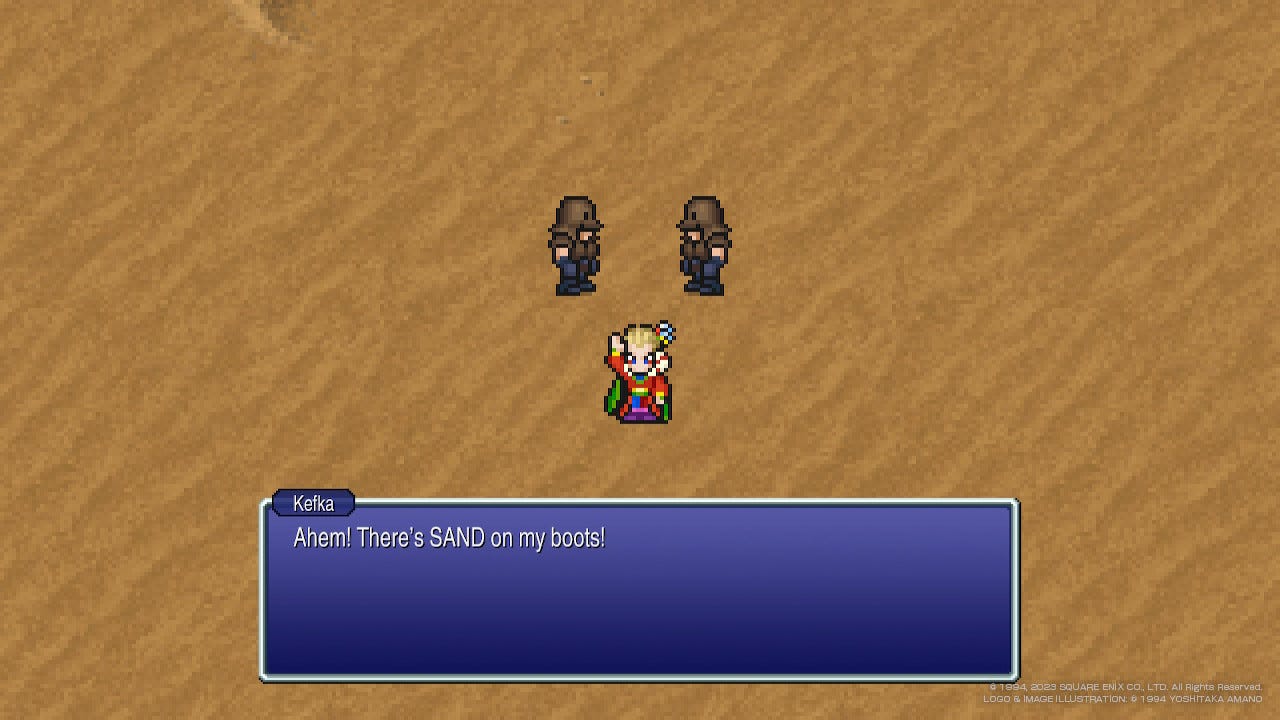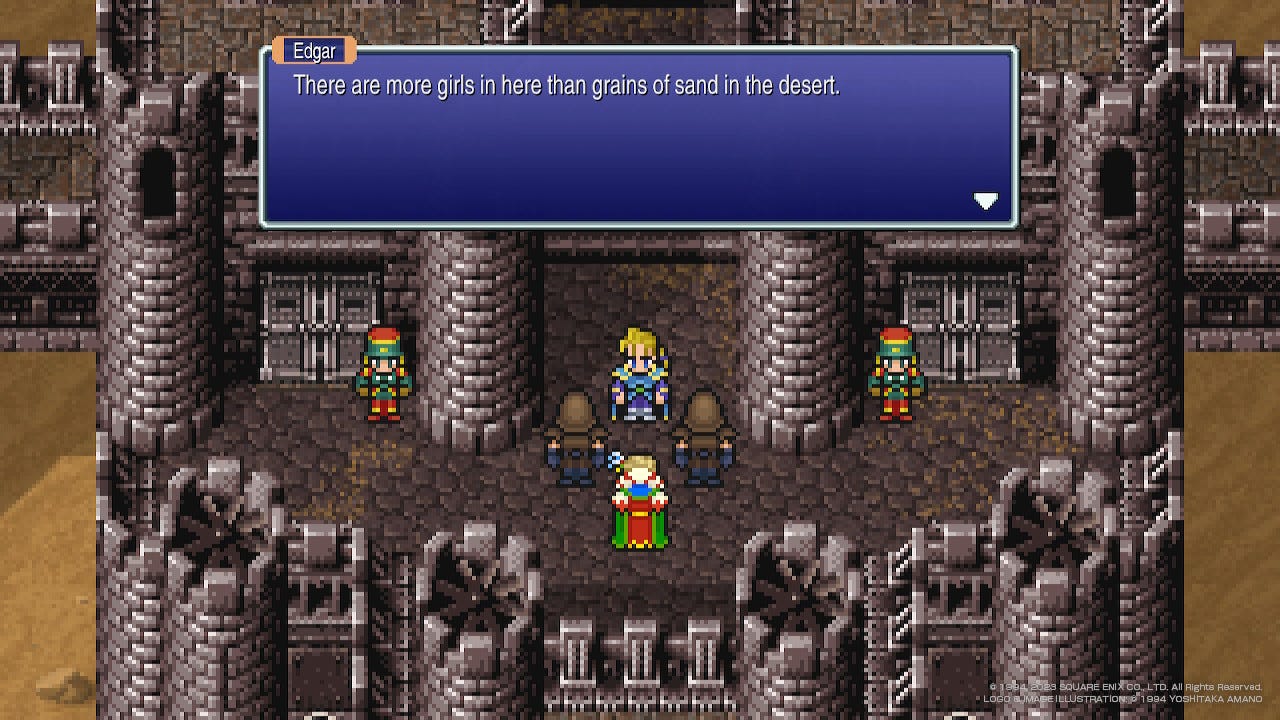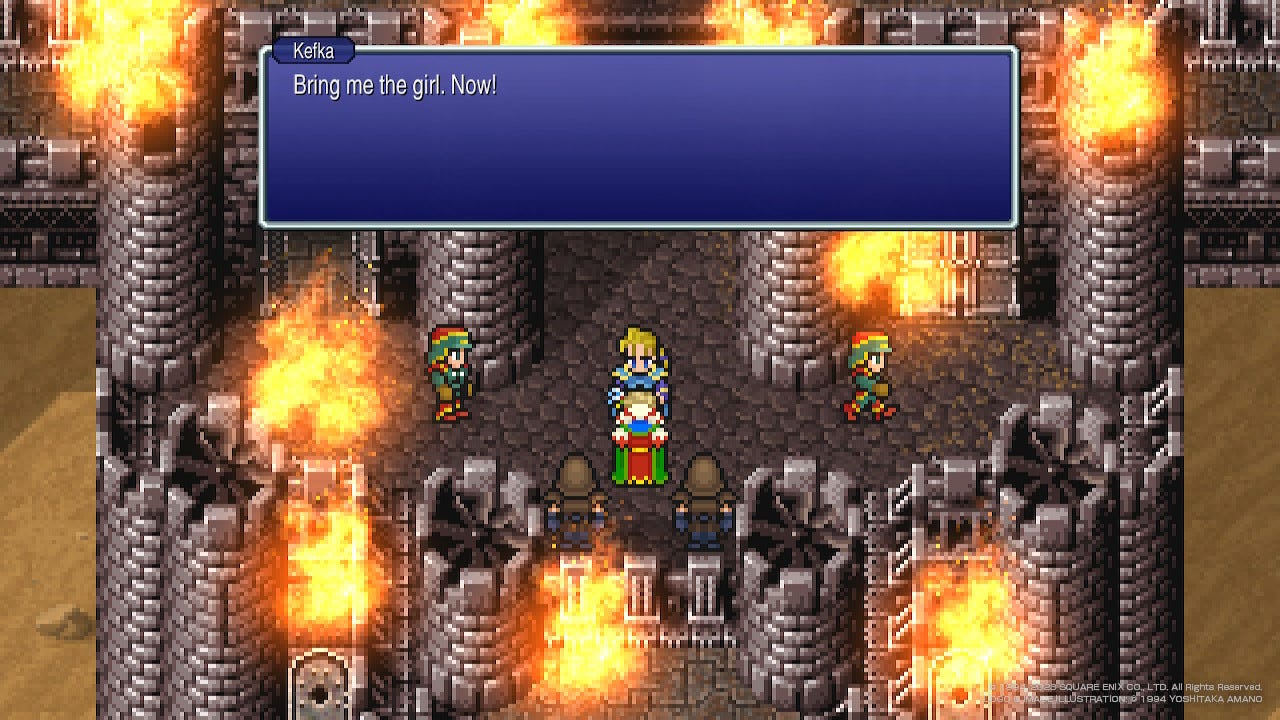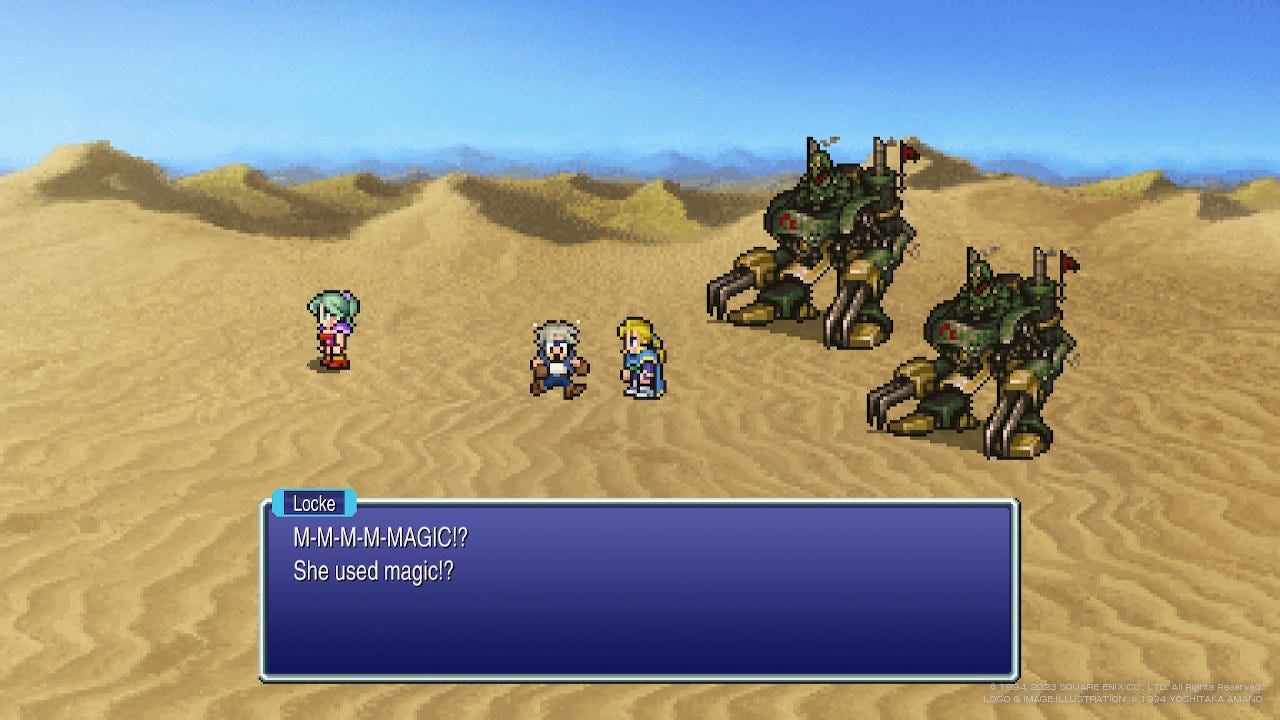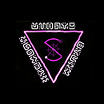Greetings, my friends! Welcome back to The War of the Magi, my new series at Dark Twins zeroing in on the Initiatory and magic(k)al themes to be found in the game Final Fantasy VI. So far, introductions have been made and a Character Tribute has been added for Terra. What next? Just to keep my readers on their toes, the scoop on where all of this is going is founded on where it came from.
I’ve mentioned my erstwhile ineptitude at this game, and honestly, at this entire kind of game, back when it was new to me. On top of that, when I did finally beat it, it was not without the help of a Game Genie, largely to level my characters to 99 in one battle and then shut off all random encounters so I didn’t have to fight any battles except boss encounters. As we proceed, I will take occasional opportunities to highlight mistakes I used to make or ways in which I simply misunderstood how RPGs are meant to be played, because it’s kind of funny and because I think there are plenty of gamers who can relate.
I admired how well my teacher, Matt, played this game and I knew how bad I was at this game. Couldn’t beat it without a Game Genie! Without everyone at Level 99 (the highest experience level in the game)! If you’re familiar with the genre, you know how pitiful that is, because the entire Final Fantasy series as a whole is not considered very difficult, and Final Fantasy VI is said to be one of the easier installments of the series (I would not know, as I’ve only played VI and VII).
As I mentioned once before, all of the above was true even though I was playing with a strategy guide (which says a lot about the quality of the strategy guide, although honestly, the one I had was one of the best ones money could buy at the time. Yes, there was a time when people spent good money on a big, shiny book called a “Strategy Guide” that had all the answers you needed about a game).
How did I educate myself?
I owe it all to Djibriel.
Sure, I could have learned the ropes some other way, but there’s just no one like Djibriel. Djibriel’s love and devotion toward knowing every single nook and cranny of this game is impressive. I always knew Matt must have been working with knowledge about the game’s mechanics that wasn’t necessarily common at the time, but I am positive Djibriel knew a lot more even than Matt. To be fair, Djibriel had an unfair advantage in that by the time they were writing their strategy guide, this game could be played on PC emulators, and so the game had pretty much been torn apart at the level of code and analyzed half-to-death. I think this is one of the ways we know about the hilarious “Evade glitch,” for example: Due to a glitch, an entire character stat—Evade—didn’t work. You could equip an item that increased that stat, but it wouldn’t have any effect because the glitch made it so that the Evade and MEvade (Magic Evade) stats were fused together, and items affecting MEvade were thus the only actual way to affect that stat in the original version of the game.
It’s thanks to Djibriel that I know things like that.
Not only did Djibriel’s walkthrough include such awe-inspiring attention to detail, it was written in a very entertaining way that included offhand, witty remarks conveying political and social commentary. It just really slapped.
As I wrote about in his character tribute, I have Djibriel to thank for transforming Gau from being next to useless in my eyes to being the backbone of my strongest parties in the World of Balance. Djibriel is how I learned the importance of different stats and how damage calculations are actually run in the background, so I would know when to override the game’s automatic “Optimal” equipment selections, which I had always used previously, with better options.
I first found Djibriel’s FAQ in the SNES section at GameFAQS. Pure .txt format. These days, it’s hanging out at Caves of Narshe, where it has a much spiffier web interface.
What I’m aiming for here is to give a genial nod to Djibriel in this series at the same time I’m giving one to Matt; that is, while Djibriel had me covered with all the odd trivia and background formulae for the game, I’ll have you covered with esoteric hermeneutics and Aeonic impressions drawn from the story (along with some of the same trivia about the game itself, and stories from my own journeys).
Playbill
Before we begin in earnest, there is one last important matter to discuss regarding this game; it has to do with something I only just recently learned about the game myself, but which, if true, explains quite a lot about the “tenacity” of this game. It also holds several keys to why this game is important—at the very least, to me.
Allegedly, the developers confirmed in an interview in the early ‘00s that the story of Final Fantasy VI was written as a perfect, five-act, Shakespearean tragedy, and this would indeed explain a lot about the ending, which features each individual character along with their theme song, with curtains on the sides of the screen in the original. My source for this is The Ultimate Final Fantasy VI Iceberg Explained (look around the 51-minute mark). This is a curious and interesting fact, especially from an esoteric perspective.
There are a few ways to tie the name of William Shakespeare to the occult, but the one that feels most relevant here is via his play The Tempest—especially since there is a weapon in this game that was named “Tempest” in the original version. The occult tie here is via the character Prospero, who is theorized to have been modeled after John Dee—Elizabeth I’s court astrologer and one of the men who brought us the Enochian system of magic(k).
Another way in which this framing of the entire story of the game as a Shakespearean play may resonate with regular readers of this site is an idea first discussed in the post Fifth Grade Book Report: “The Theater of the Word.” “The Theater” is one of what Don Webb calls “the five steads of the grade of Magus” in his book Overthrowing the Old Gods: Aleister Crowley and the Book of the Law.
Fifth Grade Book Report gives a better description of The Theater of the Word than I can offer here—and it also includes a quote from Shakespeare’s “As You Like It” which serves to drive its main point home. In short, it is the idea of how, from the viewpoint of the Magus, the entire world becomes like unto a play that, at one point in particular, becomes very intense, and the purpose of this Initiatory drama is to teach the Magus their own Word.
Another interesting connection here is that, in another part of the chapter of Overthrowing the Old Gods that Fifth Grade Book Report is based on, Don Webb mentions how different aspects of a Magus’ word will, in retrospect, be seen to have been present all throughout the life of the Magus from the very beginning. I will report in all honesty that the very first time I read this book, back in 2015, I thought back to Final Fantasy VI while reading about The Theater of the Word. Why?
Because, wedged in near the tail end of the World of Balance is what is probably the best-known and most beloved scene in the game: The Opera House scene. We’ll cross that bridge when we come to it.
I will not spoil all of these Mysteries for my readers by over-analyzing them, but it was very important for me to point them out before we begin, and those who follow this site more closely should keep them in mind.
There’s one last layer to this. I think all of this has to do with one other detail that may stand out about this game: The prevalence of Italian names in the cast. We’ll be talking about Kefka Palazzo, the game’s villain, soon enough, and he’s the first we meet. There are Edgar and Sabin Figaro, both of whom we’ll also meet later in this post. There’s Setzer Gabbiani. There’s Strago Magus, whom I’m going to count simply because I always thought “Strago” was related to the Italian “stregone” for “wizard.” I don’t know, it always stood out to me.
I am going to guess at an inspiration from the opera Pagliacci by Ruggero Leoncavallo. This is because it translates to “Clowns” in English, which I think would refer to Kefka, the game’s villain. This would make sense because Pagliacci’s protagonist is the leader of a theater company, and the plot involves the murder of his wife and her lover live on stage (they are each actors in the theater company, so this would be a stage-within-a-stage). Likewise, the opera in the game is interrupted when its lead actress is kidnapped during the performance by Setzer, all on a fictional stage within this game’s story (or in other words, a stage-within-a-stage).
I’m still pondering other potential significance to all of these Italian names; one more idea currently takes center stage, but it’s nowhere near time for that Act.
Forward March
I covered the game’s opening in previous posts, but it’s worth mentioning one more time for more than cursory reasons because it really is the first showcasing of the immense talent and care that went into this game. For a 16-bit video game, the simply cinematic quality of the opening credits is a feat to be respected.
Before these credits roll, there’s a brief intro sequence that tells the short version of the story of The War of the Magi: Once upon a time, there was magic in the world along with beings known as espers, but 1,000 years ago, the War of the Magi wiped the espers out and ever since, technology has ruled the day. Based on what we see in the opening scenes, the level of technology in the world is basically industrial: Aside from Magitek, things largely appear to be steam-powered. However, the Empire appears to have found a way to harness magic and is now using it to advance on the rest of the world. The question is posed: Is the War of the Magi about to repeat itself?
So, as far as the world in this game goes, we’ve already seen one great magical war that consumed the entire planet (they called it The War of the Magi, so I’ll brand it WMI), and apparently the first yokels to grow powerful enough to do so are making all the same mistakes all over again.
We aren’t told much about the characters marching on the town of Narshe in the opening, but based on all we’ve seen, we can guess that we aren’t playing as the good guys at the moment.
After the opening credits run, the screen cuts to the overhead view that will be our default view throughout the game, and the party splits up. The soldiers speak among one another, conferring briefly about the “witch” in tow with them, a young girl named Terra, who is rumored to have “fried” 50 Magitek-armored soldiers in under 3 minutes! However, she’s under their control due to the slave crown she’s wearing.
The three regroup and the player is given control for the first time, maneuvering the Magitek armor clumsily through the streets of Narshe. The streets are deserted, a signifier of martial law; the only other living people encountered by our party of soldiers are the occasional patches of Narshe Guard who assemble to resist them.
Reaching the back of the town, the soldiers press into the mines themselves. Here, they encounter the first Save Point, giving the player the option of saving the game. As we’ll come to know out of habit, this is because the game’s first boss is just up ahead.
The first boss of the game is a giant snail who was originally named “Whelk,” but I think its new name is much more meaningful:
Ymir.
Ymir comes to us from Norse mythology, where he is a primeval frost giant from whose body the world was created. Basically, in the beginning, there was the icy realm of Niflheim to the north (which matches somewhat with the position and climate of Narshe) and the fiery realm of Muspelheim to the south (which aligns with the Gestahlian Empire from the south, especially in that Terra’s magical power is that of fire). Ymir formed from the merger of the two, as the life power from the fire flowed into the droplets of meltwater from the ice.
The primary attack available to Vicks (it’s been corrected to “Biggs” in the translation I’m playing), Wedge, and Terra is “Magitek,” and it primarily consists of three beams: Fire Beam, Ice Beam, and Bolt Beam. Defensively, there is also Heal Beam. Terra is special, so in addition to these standard beams, she gets TekMissile, which fires a physical missile at one enemy; Confuser, which causes one enemy to attack targets at random; Banisher, which removes one enemy from the battle entirely; and Bio Blast, which deals Poison-based damage to all enemies.
The three main elements of Magitek beams are recognizable as the three primary elements of Black Magic in pretty much all Final Fantasy games. The Magitek skills are pretty straightforward: The character steps forward and fires an energy beam in the corresponding element. In this early opening part of the game, it doesn’t matter, for the most part, which beam you use, they all do basically the same damage…except while fighting Ymir.
I think this is all kind of a symbolic statement, especially showing up like this at the beginning of the game. Ymir was a primal creature of the early creation, who was soon slain by the first gods: Odin, Villi, and Ve. Likewise, we have Ymir here at the beginning of the game, for us to face down with our primary elemental attacks. This is a ceremonial re-enactment of the struggle at the creation of the universe, okay?
The trick here is twofold, teaching us battle skills like targeting and timing:
Ymir’s shell stores energy, so we should leave it alone at all costs. This means even though we are able to target it, we should not do so. If we do, our attack only fuels Ymir’s counter-attack against us, which is a round of Gigavolt, if I’m not mistaken.
We can and should, however, attack the slimy head—when it’s still visible. Every so often, it disappears, and the thing to do then is wait.
In addition, Ymir eats lightning, so even when attacking its head, one should not use Bolt Beam. They should use the Fire Beam or Ice Beam when attacking with either Vicks or Wedge, and should use TekMissile when attacking with Terra.
Heal Beam to heal when needed, but the battle will be short.
Upon defeating Ymir, the three soldiers advance to the chamber with the frozen esper. They approach.
Electricity begins to arc between Terra and the esper. The two commune. Vicks and Wedge disappear, and Terra’s Magitek armor explodes. The world goes black.
Escape
Terra wakes up inside of a house accompanied by an old man. His name is Arvis and we’ll see him more than once. He tells Terra to take it easy because he’s just removed her slave crown, which is bound to make her woozy and also rob her of her memory. Just then, she remembers her name. Like a showoff. How does Arvis know she isn’t just making this up?
No sooner does Arvis begin to clue Terra in than the Narshe Guard come banging on the door. The Imperial troops came to town with her in tow, and the cops don’t want any part of that in their town! Arvis tried to explain slave crowns to them, but they aren’t interested in excuses like that. Terra’s gotta go!
Of course, in a move that would make absolutely no sense if you were actually in this situation, don’t forget to run back to the grandfather clock right by the front door of the house where the guards are so you can get an Elixir. This is one of my favorite Final Fantasy traditions: Elixirs in clocks. Elixirs are valuable and coveted because they fully restore a character’s HP and MP and cannot be bought. It’s very common to save these for the last battle…but then, as I recall, I didn’t even use one. So we hoard these for their rarity and then never use them.
Look what capitalism has done to us.
Terra runs out the back door and into the caves of Narshe. We run her back, deeper into the cave, and there’s really only one way to go.
Not that there are many different options available to us in battle anyway, but nonetheless my entire approach to this leg of the game was different when I first started playing this game vs. what it is now. When I first started playing this game, I was afraid to spend the limited resource that was MP (Magic Points, or mana), and used “Fight” instead. Battles lasted twice as long because I had to defeat each enemy one by one.
Now I use multi-target Fire spells, which handle most fights in one or two rounds. No, Terra doesn’t have a ton of MP here at the beginning of the game…but seriously, there won’t be more than about 3 battles here anyway. Just use the MP.
Eventually, Terra is backed into a corner by the soldiers and falls through the floor in a cave-in.
While Terra is unconscious, she has flashbacks about her past which give us glimpses of her life with the Empire: We see Kefka fitting her with a slave crown, then ordering her to attack soldiers. The rumors I’ve mentioned say Terra killed 50 Magitek soldiers with her own magic, but the scene we see shows Terra attacking a regular soldier with a Fire Beam. Go figure.
We also see a somewhat disturbing scene of an Imperial rally, with the Emperor Gestahl addressing the audience as several figures look on; first-time players don’t know any of them, but veterans recognize Generals Celes, Kefka, and Leo along with Terra and the Emperor himself. After the Emperor’s speech, the crowd and generals all give their salute. Surprisingly, this was a one-handed salute very reminiscent of the Sieg-Heil, for years; in the version I am currently playing, both hands are now raised.
We are whisked back to Arvis’ house. He paces the room hesitantly as we hear the tapping sound of a door opening. A man enters the room and the two greet one another. Arvis makes the mistake of calling Locke a “thief,” and we get to witness his trademark offense and subsequent correction: It’s TREASURE HUNTER!
I’ll give him a proper introduction when I get to his own Character Tribute, but Locke is…well, Locke. Some people would never play this game without him, but I could take him or leave him.
The joke regarding TREASURE HUNTING is that his Special Command is Steal, which allows him to steal things from enemies. I’ll weigh pros and cons of this in the Character Tribute.
For now, Locke falls down to the cave where Terra landed, just as a large troop of Narshe Guards enters the chamber at the bottom of the screen.
Suddenly, Locke hears a ghostly call echoing from the chamber behind him: Kupo…
It’s the moogles! I had never heard of moogles before I played this game and I don’t know if they appear in other Final Fantasy games before it, but basically, moogles are like a cross between a koala bear, a Hello Kitty plushie, and a bat…and they’re strong warriors, too!
11 moogles in total come to join Locke, so that all together, they can form 3 full parties of 4. Then, a minigame ensues: The player can switch between the three teams, strategically placing and moving each one to keep the advancing enemy troops away from Terra. Meanwhile, we make our way down to the leader of the attack, Guard Leader.
One of the moogles is named Mog, and we should pay special attention to his team, because Mog eventually becomes a main character. His special ability is called Dance, and there is a different Dance associated with each different battle environment in the game; so if we make sure to fight at least one battle with Mog’s team, he will learn the Twilight Requiem Dance that goes with the cave environment. This is especially useful here.
Guard Leader isn’t God or anything, but since this is the very beginning of the game, resources and strength are limited, and Guard Leader actually hits pretty hard considering the circumstances. I usually fall pretty easily to him, to be honest.
I almost religiously fight him first with Locke’s team, so I can Steal the MythrilKnife from him. I’ll get into this more when I cover Locke as a character, but it’s actually a little silly to do this for a weapon that will be replaced so quickly.
When all else fails, I usually end up succeeding with Mog’s team. I use his Twilight’s Requiem Dance, and I hope that he uses the Snare attack, which just makes Guard Leader disappear into a hole in the ground. One and done.
With Guard Leader defeated, the moogles beat a hasty retreat as Locke calls back his thanks. Then he carries Terra out of the cave.
Just before exiting, Terra awakens from her fall, and the two make their introductions. Terra mentions having amnesia, to which Locke reacts with notable quickness and intensity, reassuring her repeatedly that he will not abandon her. It sounds more innocuous and simply appropriate to the situation than it does once you know him better and understand that a personal trauma about failing a past love of his is pretty much his main driver as a character.
The two are deposited to the rock walls just outside the entrance to Narshe. They won’t be let back into town, but there is one building they can enter:
The school.
Ah, the school. This is a building with three classrooms and a lobby, filled with sprites we will come to recognize as the game’s default “scholar” sprite. There are a couple of treasure chests, including a Monster-in-a-box. Basically, if you go in there and talk to everyone, you’ll get a crash course in the basic elements of playing the game: How battles work, how magic works, how status ailments work, etc. You’ll also pick up a couple of useful supplies.
I laugh at this whenever I play this game for two reasons:
It really does make a big difference knowing game theory, so if you aren’t familiar with the game, going into the school is essential. This is important because this game was tailor-made and marketed to introduce the JRPG genre to a whole market of people who had never given the genre much thought before.
Also funny because Matt was the one who taught me about ditching school. He and I used to cut class to hang out at my house and play the one other game I strongly associate with him aside from Final Fantasy VI and Magic: The Gathering. That would be WarCraft II: The Tides of Darkness.
I have problems staying focused on classwork to this very day. Thanks, Matt.
Figaro, Figaro, Figaro!
Locke and Terra don’t have too many options. Arvis has suggested Locke take Terra south to the kingdom of Figaro. Locke, thief—er, treasure hunter—that he is, happens to know the king.
Terra and Locke travel south in what is likely to be an uneventful journey; you’ll see Leafbunnies and Darkwinds in the greener areas, and stingray-type-things in the desert that are slightly more dangerous, but for the most part you’re just going to walk right down to the castle.
A soldier tries to stop you, then lets you pass. You enter the throne room, and Terra meets King Edgar Figaro: Desert-dwelling tech bro. As we saw on our way in, Figaro Castle is itself a marvel of technology. Edgar, its king, boasts about his alliance with the Empire. When Terra asks why Edgar is interested in her, he takes that as an opportunity to flirt with her before departing.
Terra is free to roam, and there isn’t really much to do to advance the plot other than going to the King’s chamber to meet the High Priestess, who tells us about Edgar’s twin brother, Sabin, in a flashback. Apparently, once their father fell ill, neither of them were particularly thrilled about taking on the throne; however, rumor had it that the succession was settled with the toss of a coin, and Sabin took his leave of the castle.
After this scene, the next time Terra returns to the throne room, Edgar will be back. A brief scene between Edgar, Terra, and Locke unfolds, but suddenly, a messenger comes with news: The Empire approaches!
We cut to a scene of Kefka walking across the desert, griping about being sent to the middle of nowhere by Gestahl. He gets sand on his boots, and gives his soldiers an opportunity to show us the meaning of the term “bootlicker.”
Upon reaching the castle, Kefka is greeted sternly by Edgar, who questions Kefka and his accompanying soldiers to learn they are looking for Terra. Denying any knowledge of their whereabouts, Edgar sends Kefka and his entourage on their way.
Edgar asks Locke to show Terra to her quarters while he makes plans, so the player assumes control of Terra and follows Locke out to the side quarters. I always like to run in front of him and go through the doors first.
Locke tells Terra a little more about what’s going on: Namely, that Edgar is only pretending to be allied with the Empire, while secretly collaborating with the Returners, a secret underground resistance organization. Arvis was a Returner too, as is Locke. All of this talk is greatly confusing to Terra, who asks Locke: But I’m an Imperial, aren’t I? And he tells her that no, of course not, they were only manipulating her! And that’s not too hard to believe of a group of people who resort to using slave crowns, right? Nonetheless, the state of uncertainty in which Locke leaves Terra is the one in which she largely remains for the rest of the game, albeit for a shifting array of reasons.
We’re brought back to a scene of Edgar’s bedroom. He stirs and rises from bed. He smells something, and runs out of the bedroom.
What’s this? Figaro is on fire!
As soon as he comes out into the courtyard, Edgar is greeted by Kefka: Since he won’t give the girl up, welcome to the barbecue! Figaro is set to the torch due to Edgar’s noncompliance.
Edgar retreats toward the throne room, and Kefka follows…is that…a change of heart?
No! Of course not! Edgar hatches his plan and hope over the rampart of the castle to land on the saddled back of an ostrich-like yellow bird:
A chocobo!
With two additional chocobos in tow, Edgar swings around the castle and picks up Locke and Terra. The team of three flee as Kefka exits the castle to watch what they do.
Now we learn the technological secret of Figaro Castle: Dive mode! The parapets of the castle are shown to retract one by one before the castle sinks beneath the dunes of Figaro Desert.
Kefka sends Magitek armor to give chase.
This is where I need to call bullshit. The lore says Terra fried 50 Magitek-armored soldiers in 3 minutes with her own magic power? I don’t think so. The ones we fight here aren’t hard to defeat, but there are two of them and three of us. The main reason I’m skeptical is that Terra doesn’t have anywhere near enough MP to cast enough Fire spells to do that.
If Terra happens to use magic in this battle, we’re treated to a scene that’s written as funny, but in many ways, it really isn’t: Locke and Edgar see her using magic and they go absolutely bonkers because no one has ever seen a living person do such a thing. It makes Terra feel extremely exposed.
Witnessing this act is a tide-turner: Once the battle is finished, Locke, Edgar, and Terra regroup. If Terra can use magic, the Returners just might have hope in their fight against the Empire. Edgar says that he would like to take Terra to meet Banon, the leader of the Returners.
This is an interesting scene, especially as one who empathizes with Terra. Locke and Edgar have saved Terra; it’s undeniable the Empire is after her, and they’ve made it clear they’re willing to commit violence to do it. That can’t be for anything good, can it? It’s obvious: Edgar and Locke are Terra’s rescuers.
She has a rare and unprecedented destructive power, which is why they want her so badly. And they saved her.
So obviously she’s going to show her gratitude by being their weapon instead, right?
See how that sounds?
When you zoom out, the answers here seem a lot more obvious: The Empire’s goals and methods both are atrocious, and everyone else in the world is just trying to live their lives. The Imperials are going to come for everyone eventually, and holy cow can Terra fight. She really might as well.
What else is she going to do? Go hide out in a cabin and pretend none of this is happening?
The game shifts to the overworld chocobo view, which is great fun. The goal of the player is to ride for the cave that leads to the town of South Figaro. If Terra, Edgar, and Locke are going to meet with Banon, they’ll need to go there first.


